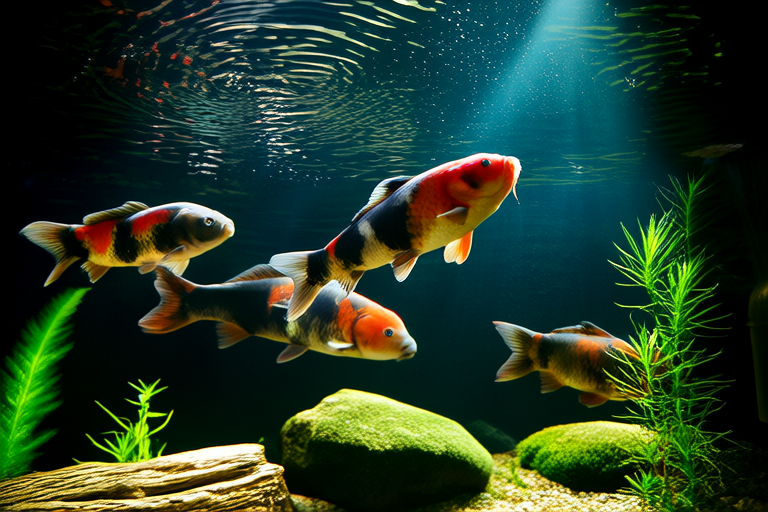
The Science Behind Koi Fish’s Vibrant Colors
Koi fish, renowned for their striking beauty and vibrant colors, have captivated human admiration for centuries. These ornamental fish, originating from East Asia, are admired for their diverse array of hues and patterns. Understanding the factors contributing to their vivid coloration is crucial for enthusiasts and breeders alike. This article explores the biological and environmental elements that shape koi fish’s appearance, delving into genetics, diet, and pond conditions.
Genetics and Chromatophores
The genetic makeup of koi fish plays a pivotal role in determining their coloration. Koi possess specialized cells called chromatophores, which are responsible for producing and displaying various pigments. Different types of chromatophores contribute to distinct colors:
- Erythrophores produce red and orange pigments.
- Xanthophores generate yellow pigments.
- Leucophores produce white pigments.
- Cyanophores generate blue pigments.
The interplay between these chromatophores results in the wide range of colors and patterns observed in koi fish. Genetic inheritance dictates which chromatophores are present and active, influencing the final coloration. Breeders have selectively bred koi for generations, focusing on specific traits such as intensity, pattern, and distribution of colors.
Historical Significance of Koi Breeding
The history of koi breeding dates back to ancient Japan, where they were initially bred for practical purposes, such as food. Over time, their aesthetic appeal became increasingly valued, leading to selective breeding programs aimed at enhancing their visual characteristics. By the late 19th century, koi had become a symbol of wealth and status, with elaborate ponds and gardens being constructed specifically for their display. Today, koi breeding remains an art form, with breeders striving to produce fish with exceptional coloration and patterns.
Diet and Color Development
A well-balanced diet is essential for maintaining and enhancing koi fish’s vibrant colors. A diet rich in carotenoids, found in algae, brine shrimp, and krill, can significantly impact coloration. Carotenoids, such as astaxanthin and beta-carotene, are precursors to red and orange pigments, respectively. Providing koi with a varied diet that includes these nutrients can lead to more intense and vibrant colors. Additionally, ensuring a balanced diet that meets all nutritional requirements supports overall health, which in turn enhances coloration.
Pond Conditions
The environment in which koi live greatly influences their coloration. Pond conditions, including water quality, temperature, and sunlight exposure, play significant roles. Maintaining optimal water parameters is crucial for color enhancement:
- Water pH should be between 6.8 and 7.8, with stable levels promoting healthy fish.
- Adequate oxygenation ensures that koi receive sufficient oxygen for optimal health.
- Proper filtration systems remove harmful substances, preventing disease and stress.
Water temperature also affects koi’s metabolism and coloration. Warmer temperatures stimulate pigment production, leading to more vibrant hues. Sunlight exposure is another critical factor; moderate sunlight encourages the synthesis of carotenoids, enhancing red and orange pigments. However, excessive sunlight can cause stress and damage to koi, so providing shaded areas within the pond is advisable.
Natural vs. Selectively Bred Varieties
Wild koi fish exhibit a more limited range of colors compared to selectively bred varieties. Natural koi typically display shades of gray, brown, and gold, with occasional red or black spots. Selective breeding has expanded the palette of colors and patterns available, resulting in varieties such as Kohaku (white base with red markings), Showa Sanshoku (black base with red and white markings), and Taisho Sanshoku (red base with black and white markings).
Selective breeding involves carefully selecting parent fish based on desired traits, such as color intensity and pattern distribution. Over generations, this process leads to fish with more pronounced and desirable colorations. However, it is important to note that selective breeding can also result in genetic issues if not done responsibly. Responsible breeding practices ensure the long-term health and vitality of the koi population.
Maintaining Optimal Pond Conditions
To enhance koi coloration, maintaining optimal pond conditions is essential. Regular water changes, proper filtration, and adequate aeration are key to providing a healthy environment. Additionally, incorporating plants into the pond can improve water quality and provide hiding places for koi, reducing stress. Ensuring a balanced diet and monitoring water parameters closely will help maintain vibrant colors. Regular health checks and prompt treatment of any issues can prevent diseases that may affect coloration.
Cultural Importance and Symbolic Meanings
Koi fish hold significant cultural importance and symbolic meanings across various cultures. In Japan, koi symbolize good fortune, perseverance, and strength. The legend of the koi ascending the Yellow River to transform into dragons represents overcoming challenges and achieving success. In Chinese culture, koi are associated with love, friendship, and loyalty. They are often given as gifts to celebrate special occasions, such as weddings and birthdays.
In Western cultures, koi are appreciated for their aesthetic value and often used as decorative elements in ponds and water features. Their vibrant colors and graceful movements add beauty to any setting. Koi have also been featured in literature, art, and film, further cementing their place in popular culture.
Conclusion
The vibrant colors of koi fish result from a combination of genetic, dietary, and environmental factors. Understanding these elements allows enthusiasts and breeders to enhance the appearance of their koi. From the historical significance of koi breeding to the scientific principles behind chromatophores, the journey of discovering the secrets behind koi’s stunning colors is both fascinating and rewarding. By maintaining optimal pond conditions and providing a balanced diet, koi owners can ensure their fish remain healthy and beautiful. Ultimately, the cultural importance and symbolic meanings associated with koi make them more than just fish; they are living works of art.






